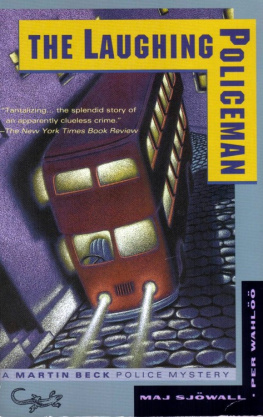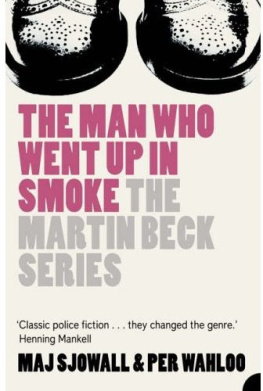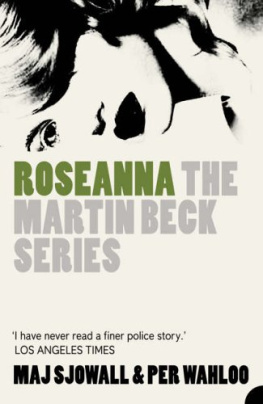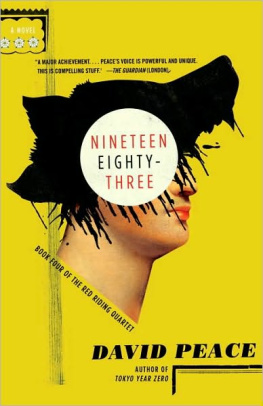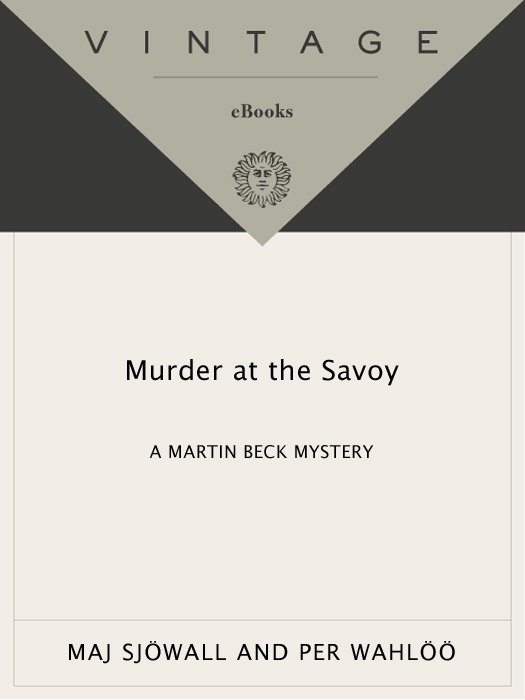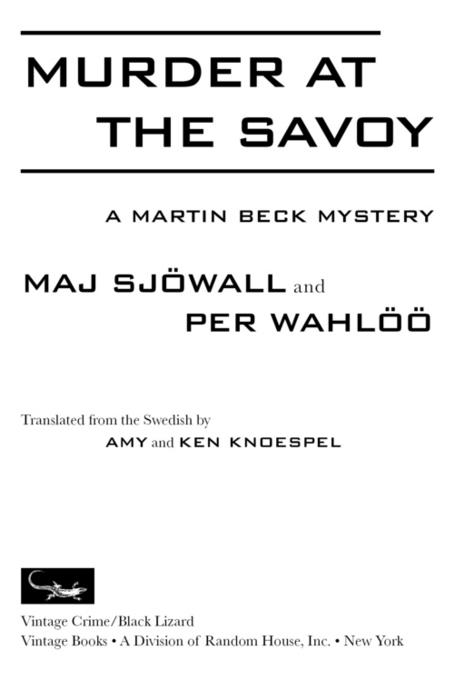Praise for
MAJ SJWALL and
PER WAHL
The first great series of police thrillers. Sjwall and Wahl caught the color of the political times and are above all truly exciting.
Michael Ondaatje
Ingenious. Their mysteries dont just read well; they reread even better. The writing is lean, with mournful undertones.
The New York Times
The whole series has an immediacy to it that is both honest and awesome. These are the kind of books you cant help but read in one sitting.
Minnesota Daily
The Sjwall-Wahl style and stories are dramas that expose fascinating truths about modern life.
Chicago Tribune
No one is more convincing than [Sjwall and Wahl] in transmitting the actual shock of brutal murder.
Buffalo News
MAJ SJWALL and
PER WAHL
MURDER AT THE SAVOY
Maj Sjwall and her husband, Per Wahl, wrote ten Martin Beck mysteries. Mr. Wahl, who died in 1975, was a reporter for several Swedish newspapers and magazines and wrote numerous radio and television plays, film scripts, short stories, and novels. Maj Sjwall is a poet. The books, together known as The Story of Crime, remain one of the greatest series of crime stories ever written.
THE MARTIN BECK MYSTERY SERIES
by
MAJ SJWALL and
PER WAHL
Roseanna
The Man Who Went Up in Smoke
The Man on the Balcony
The Laughing Policeman
The Fire Engine That Disappeared
Murder at the Savoy
The Abominable Man
The Locked Room
Cop Killer
The Terrorists
SECOND VINTAGE CRIME/BLACK LIZARD EDITION, JUNE 2009
Translation copyright 1971 by Random House, Inc.
Introduction copyright 2009 by Arhe Dahl
All rights reserved. Published in the United States by Vintage Books, a division of Random House, Inc., New York, and in Canada by Random House of Canada Limited, Toronto. Originally published in Sweden as Polis, Polis, Potatismos! by P.A. Norstedt & Sners Frlag, Stockholm, in 1970. Copyright 1970 by Maj Sjwall and Per Wahl. This translation originally published in hardcover in slightly different form in the United States by Pantheon Books, a division of Random House, Inc., New York, in 1971, and in paperback by Vintage Books, a division of Random House, Inc., New York, in 1977.
Vintage is a registered trademark and Vintage Crime/Black Lizard and colophon are trademarks of Random House, Inc.
This is a work of fiction. Names, characters, places, and incidents either are the product of the authors imagination or are used fictitiously. Any resemblance to actual persons, living or dead, events, or locales is entirely coincidental.
The Library of Congress Cataloging-in-Publication Data:
Sjowall, Maj, 1935
[Polis, Polis, Potatismos! English]
Murder at the Savoy / by Maj Sjwall and Per Wahl ; translated from the Swedish by Amy and Ken Knoespel.1st Vintage crime/Black lizard ed.
p. cm.
1. Beck, Martin (Fictitious character)Fiction. 2. PoliceSweden
StockholmFiction. I. Wahl, Per, 19261975. II. Title. III. Series.
PZ4.S61953
839.7374dc22
76042999
eISBN: 978-0-307-74430-2
www.vintagebooks.com
v3.1
Contents
INTRODUCTION
Its unusual to be able to point to the actual parents of a literary tradition. Its even more unusual when we speak of an entire genre. But that is actually the case for the Swedish crime fiction genre that is still the strongest today: the police procedural that has a perspective of social criticism. Before Maj Sjwall and Per Wahl appeared on the scene, the Swedish detective novel looked completely different. With them all the navet of the classic murder mystery was irrevocably lost.
Almost all Swedish authors who write police procedurals have at one time or another been hailed as successors to Sjwall and Wahl. In my case, it has happened rather more often than for other writers. And I have never objected. When people ask me about my role models, I usually say: Sjwall and Wahl. This is the honest truth, even though in life Im generally not particularly dependent on role modelswhether I sink or swim, I believe in going my own way. Its always better for an author to speak in his own voice.
Writers of detective novels are almost always expected to say that they dont read detective novels. And I have tended to live up to these expectations. When I took my first stumbling steps toward writing crime fiction nearly a decade ago, I could in all honesty say: I dont read detective novels.
But it wasnt always like that. In fact, I readily admit that the very opposite was true. The books that I read as an adolescent were to an absurdly high degree based on suspense fiction: nail-biting cliff-hangers, action stories, classic murder mysteries, spy thrillersyou name it. I read absolutely everything that contained even the slightest hint of suspense.
You might well ask when the adolescent mind is at its most receptive, at which age in particular and under which mental conditions the most indelible impressions are made. Fifteen is a strong candidate. It could be deemed the most manic-depressive age in anyones life. On the one hand, life seems an almost incessant torment; on the other hand, you are starting to realize who you are and, in spite of everything, what possibilities life has to offer.
Sjwall and Wahl came into my life after I had actually given up all those childish suspense books. And so I was ready for completely different literary impressions (precociously ready, that is). But when those two authors appeared, not only did they make use of all the various suspense traditions in which I had immersed myself, they also added two elements that I had been missing up until then: humor and a critical view of contemporary society.
And one more thing: an incredibly nuanced and meticulously chiseled use of language.
Its always risky to return to a reading experience that had once proved so decisive in your life. Disappointment is the rule; relief is the exception. Yet I feel no disappointment when I reread the ten books that make up the series called The Story of Crime. I may feel a bit surprised by the brief format and the relatively simple plotsand perhaps also by the unrelenting plight of Martin Becks weary attitude toward life. And yetwhat I really feel is relief. Relief that the books are still so good. That they actually are good role models. And for that I will always be grateful.
The books in the series known collectively as The Story of Crime were published in Sweden between 1965 and 1975, with one book appearing each year except in 1973. But it was in that year that Per Wahl said in an interview: In the beginning we tried to keep a low profile in order to reach an audience, but the socialist elements have undoubtedly become more prominent. As early as 1966 Wahl stated their goal with great clarity: The basic idea is, via one long novel of approximately three thousand pagesdivided into ten freestanding parts, or chapters, if you willto present a cross-section of a society that possesses a specific structure and to analyze criminality as a social function as well as its relationship to both society and the various types of moral lifestyles that encompass the society in question.
In other words: literature emblematic of the 1968 generation. It ranges from the period of dawning political consciousness in 1965 up to what might be considered the most dogmatic of years, 1975. It was supposed to be like much of the fiction coming out of 1968: so politically doctrinaire that all forms of literary tension were lost and the whole thing fell flat.


